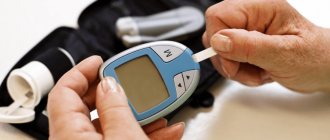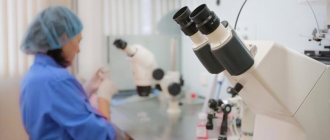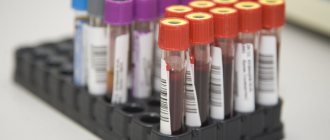Author:
- Yanova Natalya Yurievna
otorhinolaryngologist of the highest qualification category
5.00 (Votes: 3)
ASLO are antibodies against a special type of microorganism - streptococci.
When a person experiences any type of streptococcal infection, his body produces antibodies called antistreptolysin O or ASLO.
This indicator is a signal of the presence of group A β-hemolytic streptococcus (GABHS) antigen in the body. GABHS secretes the enzyme streptolysin, which is toxic to the tissues of the heart, joints, kidneys and can cause the destruction of red blood cells, a rise in temperature, and the appearance of a rash. In response to this enzyme, the body secretes antibodies - antistreptolysin O, which eliminate the waste products of bacteria, but they are powerless against streptococcus itself. Therefore, adequate and timely treatment is necessary. If the level of ASLO in the blood is elevated, this indicates infection with GABHS, which can lead to serious complications and affect the joints, heart, kidneys, and nervous system.
If a blood test does not reveal this antigen in a person or it is within normal limits, then there is no cause for concern. In addition, this is not only proof of the absence of infection, but also that the person has not had to deal with streptococcus during the last 6 months.
| Age (years) | Antistreptolysin is normal. Maximum permissible limit |
| up to 7 | 100 units/ml |
| 7-14 | 250 units/ml |
| From 14 and adults | 200 units/ml |
When making a diagnosis, it is worth considering the timing of the increase in the number of antibodies in the blood test:
- The increase in ASLO begins at 3-5 weeks of infection;
- After reaching the maximum level (at week 6), the level decreases;
- High results of ASLO can last from 6 months to a year;
- If measures are not taken in time at a high concentration of antistreptolysin, this can lead to complications in the form of rheumatic fever, and stabilization of indicators will occur after 4-8 months;
- If within 6 months. the ASLO level remains high, then the patient should expect a relapse of the disease.
Detailed description of the study
Streptococci are microorganisms that can cause a wide range of diseases in humans, from local skin lesions to sepsis (blood poisoning). They cause sore throat, pharyngitis and scarlet fever, which is more common in children.
Among this group of bacteria, group A streptococci are the most dangerous: they produce a toxin that destroys blood cells. The advent of antibiotics made it possible to effectively treat this infection. But there are types of streptococci that are resistant to antibiotic therapy. The atypical or mild course of the disease also leads to the fact that treatment is selected late or not prescribed at all.
Ineffective treatment of streptococcal infections can have negative consequences that appear some time after recovery. Both adults and children have an increased risk of developing acute rheumatic fever (ARF) and post-streptococcal glomerulonephritis. The reason for such complications is the similarity of bacterial particles and some cells of the body, due to which the immune system attacks not only the infectious agent, but also destroys the human body.
With ARF, there is an increase in body temperature, migrating joint pain, heart damage and the appearance of subcutaneous nodules. Poststreptococcal glomerulonephritis is an inflammation of the kidneys with impaired function.
In the process of fighting streptococcal infection, immune cells produce antibodies against the bacterial toxin streptolysin-O. Such antibodies in the body are called “antistreptolysin-O” (ASLO). Their presence serves as a marker of recent streptococcal infection.
ASLOs are produced about a week after the initial streptococcal infection. Their titer reaches its maximum values 3-5 weeks after the disease, and then decreases, but can remain detectable for several months. It is most informative to carry out this analysis several times to monitor the dynamics of the antibody titer.
Interpretation of results
For children under 14 years of age, reference values are lower than for older patients. The production of ASL-O in the body begins 7-14 days after infection. After 1-1.5 months, its concentration reaches its maximum value. Antibodies can be detected in the blood for some time after recovery.
A low level of antibodies or their absence makes it possible to exclude with a high degree of probability a recent infection with streptococci. To confirm, the analysis can be repeated at intervals of about two weeks. If the result is negative again, there is most likely no infection. Exceptions to this rule are rare, but still occur. In rare cases, in patients with complications after infection, ASL-O levels remain within reference values.
Exceeding the norm by 4 or more times, as well as an increase in indicators, indicate a streptococcal infection that the patient recently suffered. A decrease in antibody concentration indicates recovery. The number of antibodies can be used to judge how long ago the infection was suffered. It is impossible to judge the likelihood of complications developing, as well as their possible severity, using ASL-O indicators alone. The test results can confirm the diagnosis in patients with symptoms of glomerulonephritis or rheumatic fever. A number of factors need to be taken into account when interpreting the results. Antibody levels may increase in patients with reactive arthritis, liver pathologies and hypercholesterolemia. When taking a number of antibacterial drugs, corticosteroids, as well as in patients with nephrotic syndrome, false negative results may be obtained. This test is not used to diagnose acute infection, since ASL-O is detected no earlier than 1-2 weeks after infection.
References
- Atlas of medical microbiology, virology and immunology / ed. A.A. Vorobyova, A.S. Bykova. - M.: Medical Information Agency, 2003. - P. 37.
- Prevention of streptococcal (group A) infections. Federal clinical guidelines, 2013 - 43 p.
- Clinical recommendations (treatment protocol) for providing medical care to children with tonsillitis (acute streptococcal tonsillitis), 2015. - 29 p.
- Levanovich, V.V., Bannova, S.L., Timchenko, V.N. Evolution of streptococcal infection. Guide for doctors. - SpetsLit., 2015. - 495 p.
- Kanwal, S., Vaitla, P. Streptococcus Pyogenes. — In: StatPearls, 2021.
- Lab Tests Online: website. Antistreptolysin O (ASO), 2021. - URL: https://labtestsonline.org/tests/antistreptolysin-o-aso.
Interpretation of results and presumptive diagnoses
Doctors have the opportunity to examine changes and suggest a particular diagnosis based on the nature of the deviations in the level of antistreptolysin-O.
The following probable finds are identified:
- Increasing concentration by 4-6 times. Accompanies an infection suffered in the recent past. This is the period following the acute condition. With systematic treatment, the numbers are approximately at the same level, only the time they remain is different.
- An increase in ASLO by 1.5-2 times means chronic infectious and inflammatory processes. There is a constant, recurrent course of the disorder or carriage of streptococcus. Depending on the results of other studies, doctors decide on treatment tactics.
- Absence of any dynamics in the concentration of antistreptolysin-O for at least 6 months. Speaks of the development of an autoimmune secondary lesion. This is usually rheumatism or arthritis of non-septic origin. Targeted diagnostics are required.
With all that said, normal levels do not indicate the absence of an infectious disorder.
Attention:
It is necessary to conduct the study several times with an interval of a couple of weeks to obtain dynamic results and a complete picture of the pathological process.
But even this does not guarantee a clear outcome. Since in approximately 10-30% of situations there are no deviations for a long period of time, even with an active infection.
Chronic tonsillitis, increased ASLO 1978
Elena, Krasnodar
1731 views
April 15, 2019
Good afternoon. Child 9 years old. He does not get tonsillitis often (1-2 times a year, 2-3 times a year acute respiratory infections). In March 2021, Laura visited with complaints of hearing loss. There were plugs in the ears. The plugs were removed, but the ENT noticed enlarged tonsils. They have been enlarged since early childhood. Every time he visited a pediatrician with acute respiratory infections, he paid attention to them, but did not refer them to ENT... In March 2021, blood tests were taken: hemoglobin was increased 136 (normal 106-132), the average concentration of Hb in erythrocytes was increased 35.7 ( norm 31.8-34.6), increased relative. distribution width platelet volume 14.3 (normal 9-14), increased monocytes 0.84 (normal 0.19-0.81), increased ASLO 1026 (normal 0-150). In the same month, they took a smear test for sensitivity to antibiotics: Culture for flora with a sample. feelings. to the main AB spectrum—microorganism growth detected; Growth of normal microflora Str.rp was obtained. viridans 10՚4; microorganisms No. 1 of the Staphylococcus group were identified - Staphylococcus areus 10՚4; antibiotic sensitivity: Cefoxitin S, Penicillin R, Clindamycin S, Erythromycin S, Cefotaxime S, Oxacillin S. Other microorganisms: Haemophilus influenza 10՚4, antibiotic sensitivity: Ampicillin S, Penicillin R, Imipenem S, Ceftriaxone S, Erythromycin I ( symbols S – sensitive, R – resistant, I – intermediate). Laura's prescriptions: antibiotic Suprax, Hexoral for rinsing, Ingalipt spray, Hexoral spray, Grammidin, Sanorin Loris spray. On May 25, 2018, we passed the ASLO test. It turned out to be 1,102. On April 3, they took a blood test: the distribution width was reduced. volume of eryth. (RDW-SD) 36.6 (normal 37-54), decreased Neutrophils % 34.6 (normal 43-60), increased Lymphocytes % 50.7 (normal 30-46), increased Lymphocytes 4.16 (normal 1, 2 - 4), increased Monocytes 0.86 (normal 0.10-0.80), increased Urea 6.2 (normal 2.5-6), ASLO 1,978. On April 9, 2021, we took blood tests again in another laboratory: increased Hematocrit 40.4 (normal 32.4-39.5), Eosinophils % 4.4 (normal 0-4), ASLO 1478. Antibiotic sensitivity smear: detected Staphylococcus aureus 10՚0 (extensive growth detected) , sensitivity to antibiotics: Benzylpenicillin R >0.125, Cefoxitin Screen – Neg, Clindamycin S 0.25, Erythromycin S 1, Gentamicin S <= 1, Levofloxacin S <= 1, Linezolid S <= 4. ENT diagnosed chronic tonsillitis, decompensated form (recurrence of tonsillitis). J35.0. Carriage of streptococcus in the throat. Laura's prescription: In the nose, a solution of purified sea water, 1 dose 3 times a day for 2-3 months: in the throat gel with bacteriophages 2 times a day - 1 month, then 14 days - 3 courses; benzipenicillin (Bicillin-5) 1.5 million units intramuscularly once every 3 weeks No. 3 (in the treatment room); washing the lacunae of the palatine tonsils using the Tonsilor No. 6 device; gargle with Hexitidine (Stomatidin) solution 2 times a day – 10 days. Control after treatment with ASLO analysis. Please tell me whether it is legal to prescribe a Bicillin-5 injection, since my daughter, on the contrary, is resistant to penicillins? I am afraid to give such an injection, because... many side effects, including anaphylactic shock. When my daughter was one year old, she had rashes due to the antibiotic Cefazalin; later, it seems to me that her cheeks broke out due to Ingalipt, although after a few years we started using Ingalipt, there were no rashes. And if you still have to give an injection of Bicillin-5, how can you prevent the child from various allergic reactions, maybe take some 26 tests, a blood test?
The question is closed
tonsillitis
ASLO
bicillin-5
ASLO results in dynamics
Testing blood for ASLO levels allows you to monitor the course of the disease. For this purpose, the analysis is scheduled at intervals of seven days. The following options are possible:
- an increase in ASLO levels is recorded a week after infection. Maximum indicators are diagnosed in the third to fifth week. If the body’s immune system copes with the pathogen, then the level of ASLO begins to decrease and reaches normal levels within six months;
- a persistent increase in enzyme levels should be alarming. Because it becomes a sign of a developed complication - rheumatism (rheumatic fever). The pathological process can develop after a sore throat. In this case, long-term and persistent ASLO activity is observed;
- a decrease in the ASLO titer by the end of the first month of the disease becomes a sign of a favorable course of rheumatism, i.e. the heart is not involved in the pathological process. When selecting adequate therapy, treatment periods may be reduced;
- Steadily increased ASLO indicators within six months from diagnosis of the disease indicate a high probability of developing a relapse of the pathology.
It is worth remembering that the level of ASLO in the blood during the development of rheumatism in some people remains normal. Such patients account for approximately 15% of all diagnosed cases of pathology.

A consistently high level of ASLO can be recorded in the absence of pathological symptoms typical of rheumatism. In this case, a person can be suspected of having the following diseases in a chronic form:
- tonsillitis;
- rheumatoid arthritis.
In addition, a similar result can be observed in carriers of streptococcal infection. The infectious agent is dormant and can be activated at any time.
Streptococcal infection can provoke the development of a rheumatic process and cause acquired heart disease in a child. For this reason, after any infection, it is necessary to check the child’s blood for the ASLO value. This will help determine the true cause of the illness.
A blood test for ASLO can also be prescribed to an adult to confirm rheumatoid arthritis. The interpretation of the results obtained should be carried out by a qualified specialist. Independent interpretation of blood biochemistry indicators is unacceptable.
Additional examinations
A disorder involving high levels of antistreptolysin-O cannot be detected by this test. It allows you to state the existence of a problem, partially assess its stage, but nothing more.
It is necessary to assign a system of measures as early as possible to obtain complete information.
Among the methods, in addition to our own analysis for ASLO, we can name the following:
- Throat swab. Plays a key role, especially in the detection of acute pathological processes. The task is to assess the flora and its sensitivity to antibiotics of specific species.
Several issues are being addressed at once. The first concerns the statement of the existence of a problem, the detection of streptococcus in a smear. The second is determining treatment tactics. Early selection of medications to combat the disorder.
- General blood test. Used to indirectly confirm the presence of a pathological process. The level of leukocytes and ESR increases, and some other indicators may change. This is not so significant. Especially if the patient has already received any treatment before the start of a comprehensive diagnosis.
- Visual assessment of the condition of the pharynx, structures of the upper respiratory tract. It is carried out as part of an initial examination by an ENT doctor. It’s a routine technique, but that doesn’t make it any less important.
- Biochemical blood test.
In addition to those mentioned, those methods are also shown that can specify the condition of the heart and kidneys. To assess complications and immediate possible causes of changes in ASLO levels. ECG, ECHO, ultrasound of internal organs.
Increasing ASL-O
An increase in the concentration of antistriptolysin-O is observed in the following diseases:
- angina;
- tonsillitis;
- endocarditis;
- rheumatism;
- pyoderma;
- osteomyelitis;
- reactive arthritis;
- scarlet fever;
- glomerulonephritis;
- erysipelas.
Note : determination of the ASL-O indicator is necessary for diagnosing streptococcal infection during remission. However, the analysis is not informative enough, since an increase in the level of ASL-O antibodies in patients is possible only in 75% of cases. Therefore, diagnosis in the presence of certain symptoms characteristic of streptococcal diseases is necessarily supplemented by other laboratory tests.
An excess of ASL-O concentration by 3-4 times may indicate a recent illness caused by streptococcus.
Important! A high concentration of antibodies in pregnant women does not affect the formation and development of the fetus, the course of pregnancy or the general well-being of the expectant mother.






